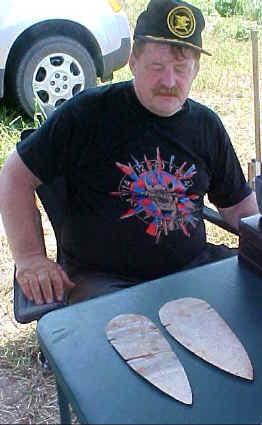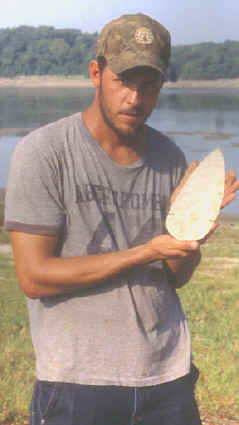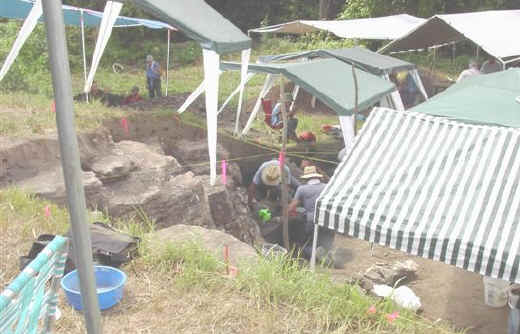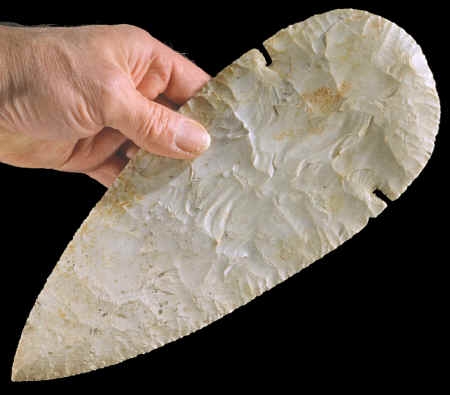|
PAGE
1
CACHE OF 2
LARGE NOTCHED BIFACES
OLIVE BRANCH
SITE
SOUTHERN
ILLINOIS
EARLY
ARCHAIC
EST. 9,500 PLUS YEARS AGO
PAGE 1
OF 2 PAGES
COPYRIGHT
AUGUST 31, 2003 PETER A. BOSTROM


PHOTOS
CREDITS, LIZ KASSLY AND RICHARD MICHAEL GRAMLY, PhD.
DR.
MIKE GRAMLY & TWO LARGE NOTCHED BIFACES
& JASON NERALICH HOLDING HIS DISCOVERY
OLIVE BRANCH SITE
ALEXANDER COUNTY, SOUTHERN ILLINOIS
Taking a break on a hot August 2003 day soon after the discovery
of two large notched bifaces on the Olive Branch site. Dr. Mike
Gramly is contemplating what are probably the largest Early Archaic "notched" bifaces ever found
during a scientific excavation in the Mississippi Valley.
The picture on the right show the discoverer of the
Neralich cache, Jason Neralich. He is holding the larger of the
two bifaces. The Mississippi River is in the background |
|
|

|
|
TWO
NOTCHED BIFACES &
THE OLIVE BRANCH SITE
EARLY ARCHAIC PERIOD
The
Olive Branch site is an Early Archaic site that's been the focus
of an archaeological program
for a number of years by Dr. Richard Michael Gramly and
volunteers. The site is mainly represented by the Dalton culture and
dates to well over 9,500 years ago.
Other Early Archaic points that have been found above the Dalton zone include Agate Basin, Hardin Barbed and corner notched
"Thebes-like" points. The Olive Branch
site has been known as a source for Stone Age artifacts by the local
people ever since a
right-of-way was sold in 1899 to a railroad company and tracks were laid
through the property. In 1986, when the site became threatened by
artifact diggers, Dr. Gramly organized the current and ongoing
archaeological program to gather as much information as possible about this
important site.
The recent discovery of a cache of two large
notched bifaces at Olive Branch was a significant find. Their
size, shape and the fact that they were stained with red ochre
signifies they were probably items used in a ritual context. No
bones were found in the feature. |
|
"The Neralich Cache appears to have been interred within a
small pit. The bifaces were enveloped in red-tinged soil
suggesting that they may have been wrapped in ochre-painted robes,
matting, or some other sort of pliable covering. The absence of
human bone, calcined or otherwise, indicates that the bifaces are
not grave offerings. A more likely explanation for this
spectacular pair of blades is that they are sculptures
representing ancestral men and women. They may have embodied the
spirits or ghosts of the Very Early Archaic folk who resided at
the Olive Branch site." ---Richard
Michael Gramly, PhD.
|
|
|
" Since 1986, archaeological excavations at
the Olive Branch site at Thebes Gap on the bank of the Mississippi River
have laid bare an important stratified sequence of archaeological
deposits."
---Richard
Michael Gramly, PhD.

PHOTO CREDIT LINDA BOLLENBACH
EXCAVATION AREA
THE OLIVE
BRANCH SITE---AUGUST 2003
CACHE
OF 2 LARGE NOTCHED BIFACES
OLIVE BRANCH SITE
ALEXANDER CO., SOUTHERN ILLINOIS
The
picture above shows a portion of the Olive Branch site as it looked in August
2003. On the 19th, two very
large notched bifaces were discovered during the excavation. The cache
was found by Jason Neralich and is now referred to as the Neralich cache
after the finder. The bifaces are impressive for their size and artistic
design (manufacturing skill) and were apparently intended for some type of ritual use.
|
|

CLICK ON
PICTURE FOR LARGE TRIPLE IMAGE
LARGE NOTCHED
BIFACE
OLIVE BRANCH SITE
ALEXANDER COUNTY, SOUTHERN ILLINOIS
PRIVATE COLLECTION
This is the largest of the two large notched bifaces that were
discovered during the August 2003 excavation on the Olive Branch
site. It is probably the largest Early Archaic corner notched point
ever found during a controlled scientific excavation and may in fact be the
largest ever found in the Mississippi Valley. This point was
probably never used domestically because of its size, style and the
fact that it was found in a red ochre stained cache. These characteristics place it
outside the
parameters of "normal" functioning tools. It is made of
Burlington chert and measures 11 inches (27.9 cm) long and 4 1/2
inches (11.4 cm) wide. There is one "hump" in the center
that measures 11/16 inches (17 mm) thick but most of this biface is
less than 1/2 of an inch (12 mm) thick. |
|
|
The Neralich
bifaces were found in a level assigned to the Early Archaic period
estimated to be more than 9,500 years old. Dr. Gramly believes they may
represent some of the earliest notched points in this period and appear
just above Dalton and Agate Basin points.
|
|
CONTINUE ON TO PAGE
TWO
|
|
"REFERENCES"
1985,
Perino, Gregory, "Selected Preforms, Points, and Knives of the North American Indians,
Vol. I," Thebes, pp. 376, 377 & 378.
1995, Gramly, Richard Michael, "VI. The Olive Branch Site: The
Initial Archaic Period In Southern Illinois," p.62.
2002, Gramly, Richard Michael, "Olive Branch, A Very Early
Archaic Site On The Mississippi River."
Personal communications with Mike Gramly.
Personal communications with Larry Kinsella.
|
|
HOME
ORDERING |




